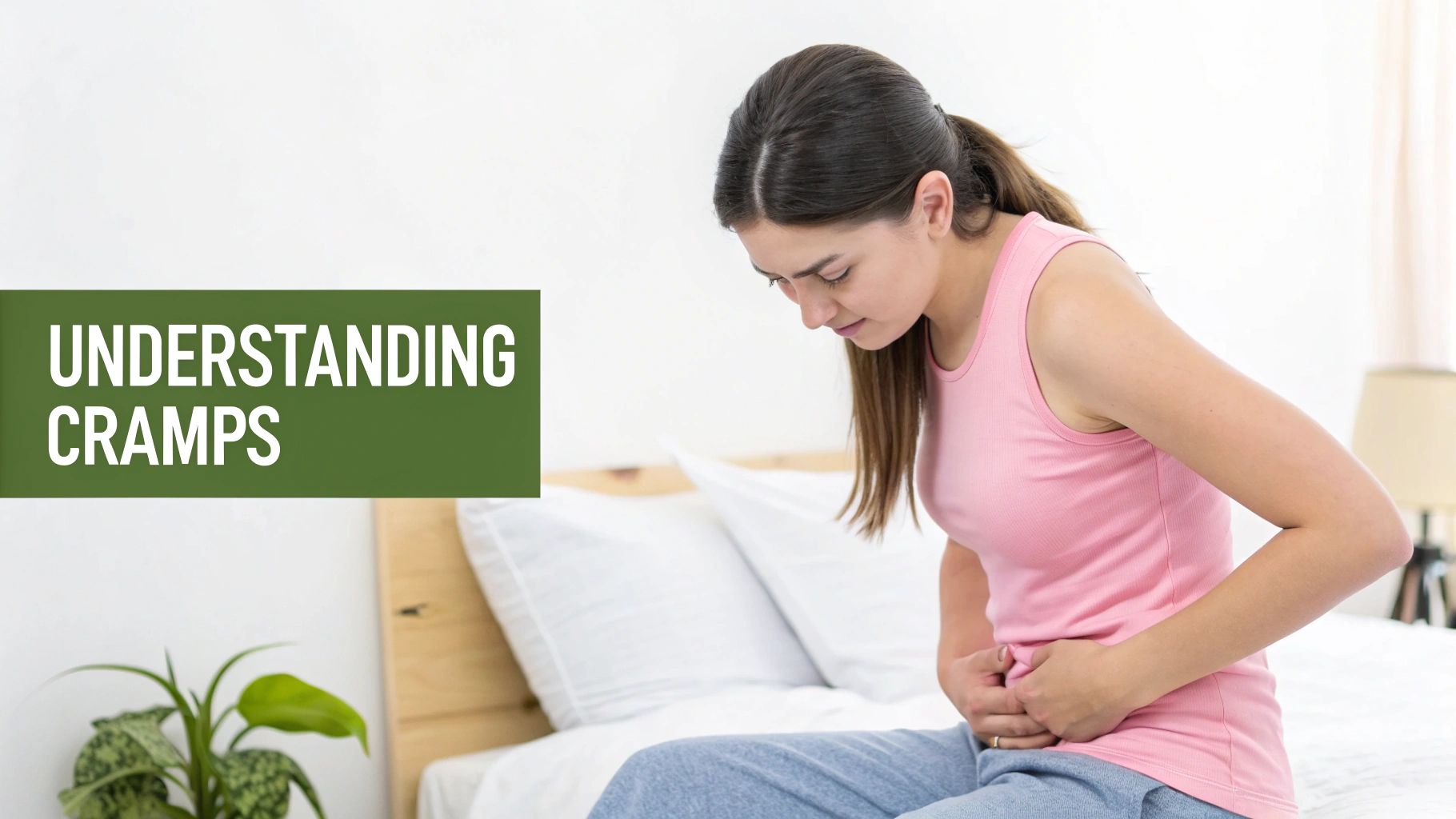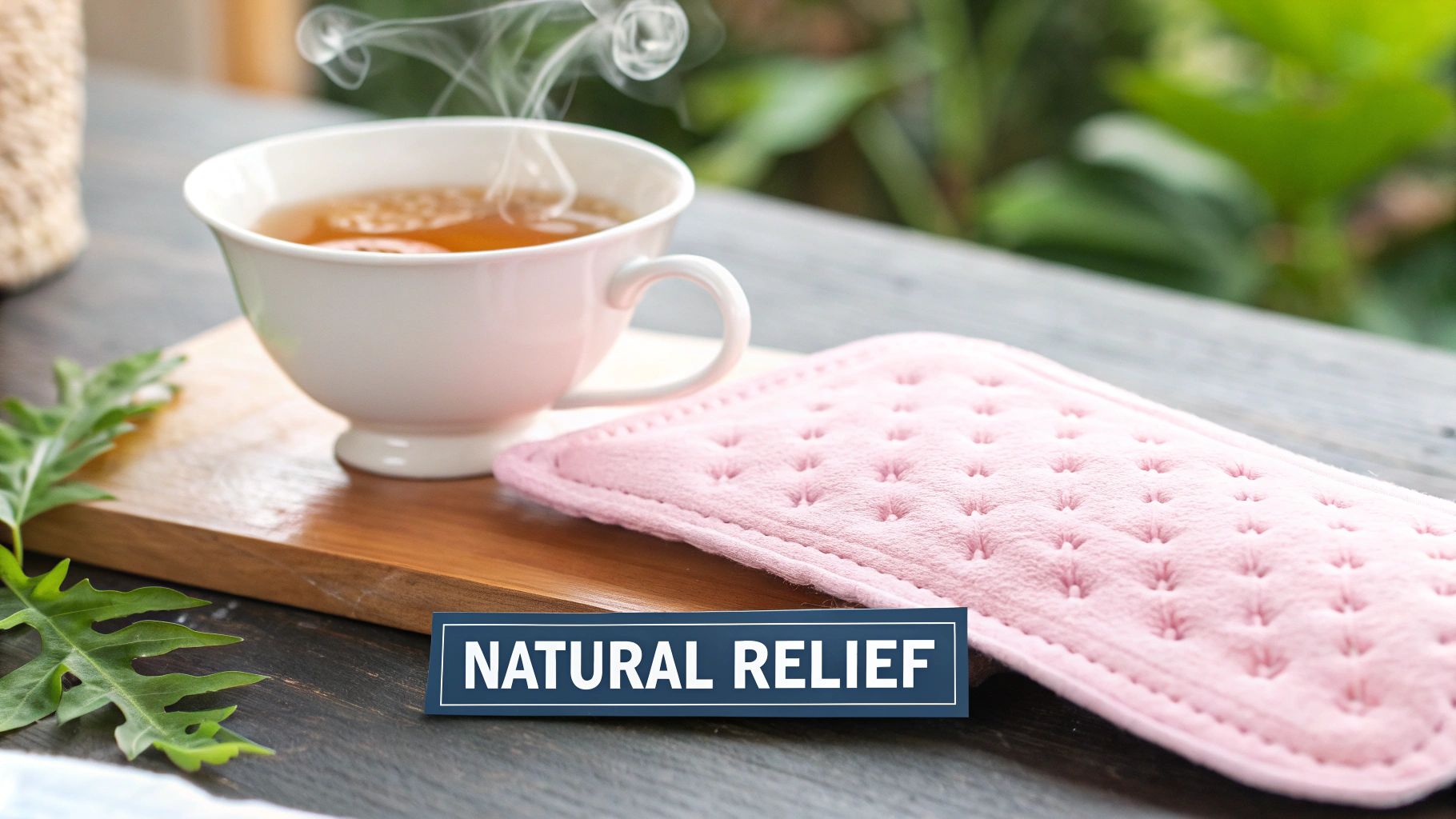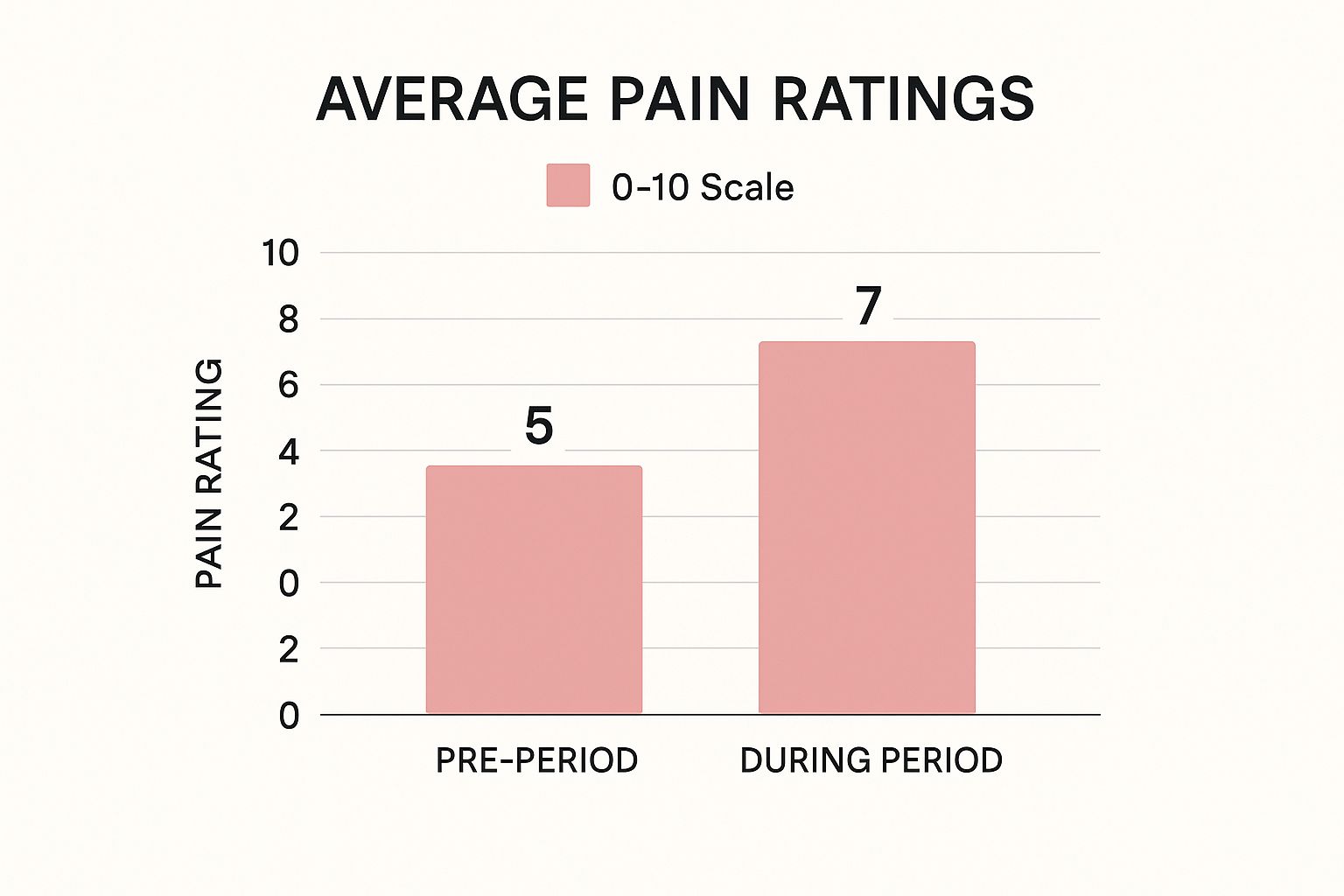
Cramps Before Period And How To Manage Them
Share
That familiar, unwelcome ache in the days leading up to your period is an experience most of us know all too well. But it’s not just a random pain. The simple truth is that cramps before your period are typically caused by natural, hormone-like compounds that are busy preparing your uterus for menstruation. Understanding what’s actually going on inside your body is the first step toward feeling more in control.
Why You Get Cramps Before Your Period Starts

If you've ever wondered what’s happening in there when you feel those pre-period cramps kick in, you're not alone. The main culprits are hormone-like substances called prostaglandins. Think of them as tiny messengers that tell your uterus it's time to contract and shed its lining.
This whole process is a completely normal and necessary part of your menstrual cycle. You can almost imagine your uterus as a powerful muscle getting a bit of a workout; those contractions it performs are what you feel as cramps. And just like any workout, the intensity can really vary.
Understanding Primary Dysmenorrhea
For most people, this pre-period pain is known as primary dysmenorrhea. That's just the medical term for common menstrual cramps that aren't caused by another underlying health condition. They are a direct result of your body’s natural rhythm.
Symptoms usually include:
- A throbbing or aching pain in your lower abdomen.
- Discomfort that can sometimes radiate to your lower back and thighs.
- Pain that typically starts a day or two before your period and eases up after the first couple of days.
This type of cramping is a standard feature across the 4 phases of the menstrual cycle, particularly in the lead-up to menstruation.
It's helpful to view these cramps not as a flaw, but as a sign that your reproductive system is actively doing its job. This shift in perspective can make the whole experience feel a lot less frustrating.
In some cases, however, cramps can be caused by an underlying medical issue—this is called secondary dysmenorrhea. This is less common and is often associated with conditions like endometriosis or uterine fibroids, where the pain might be more severe or persistent. Knowing the difference is key to understanding your body’s signals and when to seek support.
The Science Behind Pre-Period Pain

To really get to grips with why cramps happen before your period, we need to look at the chemistry happening behind the scenes. The main players are hormone-like compounds called prostaglandins, which your body produces in the lining of your uterus.
Their job is to signal your uterus to contract so it can shed this lining—which is what your period actually is.
Just before your period is due to start, your prostaglandin levels spike. This sudden increase is the direct trigger for those all-too-familiar cramping sensations. Think of it this way: the more prostaglandins you have, the stronger your uterus will contract, and that often translates to more intense pain.
This direct link explains why cramps can feel so different from person to person, and even from one of your own cycles to the next.
Primary vs. Secondary Dysmenorrhea
It’s also really helpful to know that there are two main types of period pain.
Most of us experience what’s known as primary dysmenorrhea. This is just the clinical term for the standard cramps that are a natural, albeit painful, part of the menstrual cycle. They’re caused directly by those prostaglandins we just talked about.
Secondary dysmenorrhea, on the other hand, is when the pain is caused by an underlying medical condition like endometriosis, adenomyosis, or uterine fibroids. The cramps might feel similar, but their root cause is totally different.
Knowing the difference is the first step toward finding the right way to manage your pain and figuring out when it’s time to chat with a doctor. You can explore our guide to get a clearer picture of what period cramps feel like and what’s typical.
By learning the "why" behind your cramps, you're not just putting up with the pain—you're gaining clarity. This knowledge empowers you to interpret your body’s signals with confidence and find what actually works to help you feel better.
This experience is incredibly common right across Aotearoa. In New Zealand, dysmenorrhea is highly prevalent. Research shows that anywhere from 53% to 90% of menstruating Kiwis experience some level of period pain, making it a major part of reproductive health.
One review found that while 53% of women reported pain overall, rates soared as high as 90% for those who sometimes or always have pain with their period.
Identifying Different Types Of Menstrual Pain
Pain is such a personal thing, but getting to know its unique personality can be incredibly empowering. For many of us, cramps before a period feel like a persistent, throbbing ache low in the abdomen. Sometimes, that discomfort can even wrap around to your lower back or travel down your thighs.
This sensation rarely comes alone. It’s often joined by other familiar premenstrual symptoms (PMS) – you might notice that bloating that makes your favourite jeans feel a bit too snug, or experience mood shifts that leave you feeling more irritable or tired than usual. These are all signs of the same hormonal cascade getting your body ready for your period.
What Is Typical Cramping?
Figuring out what’s considered "typical" is the first step in understanding your body's signals. For most people, pre-period cramps are a dull, steady pain that is manageable, even if it’s no fun.
The pain usually follows a pretty predictable pattern:
- It starts one to two days before your period arrives.
- The intensity often peaks during the first 24-48 hours of your flow.
- It then gradually fades as your period continues.
This chart gives a good visual of the typical pain progression many people experience.

While cramps before a period can be quite uncomfortable, the pain often ramps up once your period actually starts.
These experiences are incredibly common across Aotearoa. A recent nationwide survey of young women in New Zealand found that a staggering 89% reported regular dysmenorrhea (period pain). On top of that, 78.1% experienced fatigue and 72.5% reported mood changes, showing just how much these symptoms can impact daily life. You can discover more insights about these menstrual health findings and their effect on young Kiwis.
Comparing Menstrual Cramps and Potential Red Flags
While some discomfort is normal, severe or unusual pain shouldn’t be brushed off. It’s so important to know the difference between typical cramps and potential red flags so you can advocate for your health with confidence.
This table is designed to help you differentiate between what’s generally considered normal and what might be worth a chat with your doctor.
| Symptom/Characteristic | Typical Pre-Period Cramps (Primary Dysmenorrhea) | Potential Red Flags (May Indicate Secondary Dysmenorrhea) |
|---|---|---|
| Pain Intensity | Mild to moderate, usually manageable with over-the-counter relief. | Severe, debilitating pain that disrupts your daily activities. |
| Timing | Starts 1-2 days before your period and eases after the first couple of days. | Pain that starts much earlier, lasts throughout your period, or occurs at other times in your cycle. |
| Response to Medication | Usually improves with common pain relievers like ibuprofen. | Little to no relief from over-the-counter medications. |
| Associated Symptoms | May include bloating, fatigue, or moodiness. | May be accompanied by heavy bleeding, pain during sex, or bowel issues. |
Think of this table as a tool to help you interpret your body’s signals. If your symptoms consistently fall into the "Potential Red Flags" column, it’s a good sign that it’s time to reach out to a healthcare provider.
Proven Strategies For Relieving Period Cramps
When cramps start to creep in, knowing what to do can turn a day of misery into one of manageable self-care. It’s all about finding what works for your body, and thankfully, some of the most effective remedies are also the simplest.
A heat pack or hot water bottle pressed against your lower abdomen can work wonders. The warmth helps to relax the contracting muscles in your uterus, providing direct relief from that deep, aching pain. A warm bath does the same job, soothing not just your cramps but your entire body and mind.
Gentle Movement And Lifestyle Tweaks
While curling up on the sofa feels like the only option, gentle movement can be surprisingly effective.
Light activities like walking, stretching, or a slow yoga flow can increase blood flow and release endorphins—your body’s very own natural painkillers. You don’t need an intense workout; just moving your body can help ease that tight, clenched feeling in your abdomen and lower back.
A few small adjustments in the days leading up to your period can make a big difference, too.
- Stay Hydrated: Drinking plenty of water helps reduce bloating, which often makes cramping feel ten times worse.
- Ease Up On Caffeine: That second coffee might be tempting, but caffeine can sometimes increase tension and anxiety, potentially intensifying your cramps. Try swapping it for a calming herbal tea.
- Choose Your Products Wisely: Discomfort can be aggravated by the very products you’re using. Opting for comfortable, non-irritating options like digital (non-applicator) tampons made from organic cotton can ensure you aren’t adding any extra irritation or pressure.
Finding relief is about creating a personalised plan. It's about empowering yourself with choices—from a soothing heat pack to a gentle walk—so you can actively manage your symptoms instead of just enduring them.
Over-The-Counter And Natural Options
For that more intense, can’t-think-straight kind of pain, over-the-counter relief can be a lifesaver.
Medications like ibuprofen are non-steroidal anti-inflammatory drugs (NSAIDs) that work by directly targeting and reducing your body’s production of prostaglandins. By dialling down those prostaglandin levels, they lessen the intensity of uterine contractions and, in turn, the pain. Just be sure to follow the package directions and have a chat with a pharmacist if you’re unsure.
Beyond period-specific remedies, exploring natural remedies for chronic inflammation can also be helpful, since inflammation is a key driver of menstrual pain. If you're looking for more ways to manage discomfort, our detailed guide offers further insights into period pain relief.
Building a comprehensive approach that combines these different strategies allows you to respond effectively to what your body needs, helping you feel more prepared and in control each cycle.
Understanding The Impact Of Period Pain In New Zealand
Those cramps you feel before your period? They aren't just a personal inconvenience. They're part of a much bigger conversation happening all over Aotearoa.
When menstrual pain is bad enough to stop you in your tracks, it doesn't just hurt—it disrupts everyday life. It can affect everything from whether you can make it to school to how productive you are at work. Your experience is a shared one, and it connects you to a national movement pushing for better menstrual health for everyone.
This ripple effect is especially tough on younger Kiwis. Trying to manage intense cramps while keeping up with schoolwork is a huge challenge. It’s hard to focus on learning when you're dealing with persistent, distracting pain.
Period Pain And Its Effect On Daily Life
The impact of period pain (dysmenorrhea) in New Zealand goes far beyond physical discomfort, creating real social and educational hurdles.
In fact, research has found that about 27% of New Zealand school students report sometimes or always missing school because of period-related pain and symptoms. This isn't just a day off; it's absenteeism directly linked to the severity of their cramps, which can seriously affect academic performance and overall wellbeing. You can read the full research about these impacts on young people to get a sense of just how big this issue is.
And this isn't just a teenage problem. The same study highlighted that the vast majority of people with conditions like endometriosis (83.6%) and chronic pelvic pain (89.1%) experienced pelvic pain with every single period. This creates huge disruptions across their social, work, and financial lives, highlighting just how badly we need better support and education.
The Push For Period Equity In Aotearoa
Recognising these challenges has fuelled a growing movement for period equity in New Zealand. The concept is simple but powerful: everyone who menstruates should have access to the products, education, and support they need to manage their period with dignity and without shame.
It’s all about making sure that a natural biological process doesn't become a barrier to education, work, or opportunity.
This conversation has already led to real progress, including initiatives to provide free period products in schools across the country. By tackling "period poverty"—the lack of access to sanitary products due to financial constraints—we can help ensure no student has to miss class simply because they have their period.
The goal of period equity is to destigmatise menstruation entirely. It's about creating a society where talking about periods is normal, accessing products like digital (non-applicator) tampons is easy, and seeking help for severe pain is encouraged, not dismissed.
This shift helps to normalise common menstrual troubles and validates what countless Kiwis go through every month. By understanding that your struggle with cramps is part of a wider societal issue, you become part of the solution. Every conversation helps break down old taboos, paving the way for a future where menstrual wellbeing is prioritised for all.
When To See a Doctor About Your Cramps
While cramps before your period are a totally normal part of the deal for many of us, it’s just as important to know when your pain might be trying to tell you something more. You know your body better than anyone, so trusting your gut is everything. If your cramps suddenly feel different, are way more intense, or are starting to mess with your life, it's a good time to check in with a doctor.
Let’s be clear: seeking help for pain is never an overreaction. Pushing through severe discomfort isn’t a rite of passage, and a doctor can help you find real answers and relief. Remember, you are your own best advocate when it comes to your health.
Key Signs It’s Time for a Chat
Sometimes it's hard to tell what crosses the line from "annoying but normal" period pain to something that needs a proper look. Keeping an eye out for a few red flags can help you feel more confident about booking that appointment.
Think about getting some medical advice if you experience any of these:
- Pain that disrupts your daily life: If your cramps consistently force you to call in sick to work, skip school, or bail on your usual activities, it's time to get support.
- Cramps that get progressively worse: Pain that seems to ramp up with each cycle or hangs around for longer than it used to is a big sign to get it checked out.
- No relief from over-the-counter medication: When standard pain relievers like ibuprofen or paracetamol barely make a dent, it could suggest there's something else going on under the surface.
How to Prepare for Your Appointment
To get the most out of your visit, a little prep can go a long way. This helps your doctor get a really clear picture of what you’re going through.
A great idea is to track your symptoms for a couple of cycles before you go. Note down the intensity of your pain (maybe on a scale of 1-10), when it starts and stops, and any other symptoms you notice, like bloating, heavy bleeding, or mood changes. This kind of information is gold for your doctor.
Having these details handy makes it so much easier for you to explain your situation clearly. It helps ensure your concerns are actually heard and properly looked into, which gets you one step closer to finding a solution that works for you. You don’t have to figure this out alone.
Your Top Questions About Pre-Period Cramps
To wrap things up, let's get into some of the most common questions we hear about cramps that show up before your period. Getting clear, straightforward answers is the first step to understanding what your body is trying to tell you.
Can Stress Really Make My Cramps Worse?
Absolutely. When you're stressed out, your body pumps out a hormone called cortisol. Think of it as your body's built-in alarm system.
High cortisol levels can throw your delicate reproductive hormone balance out of whack, which can make those pre-period cramps feel so much more intense. It’s a perfect example of the mind-body connection in action. This is why finding ways to manage stress—like a gentle walk, some stretching, or a few minutes of mindfulness—can have a surprisingly powerful effect on your period pain.
Is It Normal For Cramps To Change As I Get Older?
Yes, it’s completely normal for your relationship with cramps to evolve over the years. For many people, cramps actually become less severe after having a baby or as they head towards perimenopause.
The important thing to watch for is a sudden, significant change. If your cramps suddenly get much worse or feel different, it’s always a good idea to have a chat with your doctor. They can help rule out any underlying issues and give you peace of mind.
Are There Specific Foods That Can Help With Cramps?
Your diet can definitely be a powerful ally. Certain foods can help calm things down in your uterus.
- Magnesium-rich foods: Think leafy greens, nuts, and dark chocolate. Magnesium is known for its muscle-relaxing properties.
- Omega-3 fatty acids: Found in oily fish like salmon, plus flaxseeds and walnuts, these are brilliant for reducing inflammation.
On the flip side, you might find that cutting back on salty foods and caffeine in the days leading up to your period helps reduce bloating and ease that familiar ache. It’s all about tuning in and figuring out what feels best for your body.
At Crimson Organic, we believe managing your period should be simple and comfortable. Our certified organic digital tampons are designed with your body and the planet in mind, offering a pure and reliable choice for your cycle. Explore our range and build your own subscription at https://crimsonorganic.co.nz.
